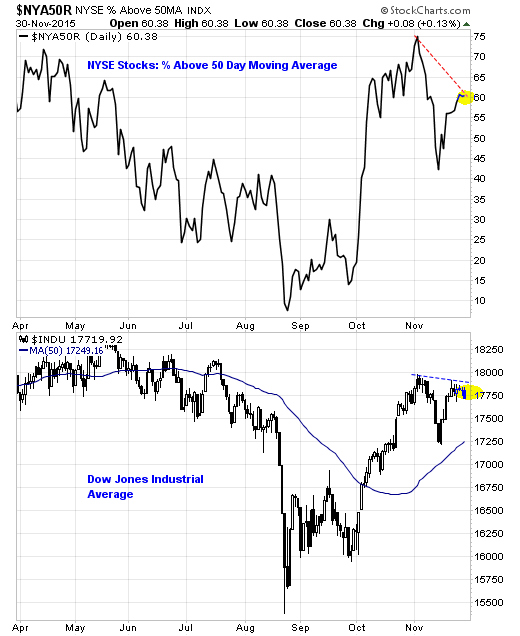The stock market is calm -- that's worrisome
Investors likely have a lot of other things on their minds these days. Holiday travel. Black Friday deals. Cyber Monday promotions. NFL playoff hopes.
The stock market may be way down on the list by virtue of its recent stability. After all, after swinging wildly between August and October, large-caps have barely budged. But some market watchers fear that period of quietude could amount to the calm before the storm.
The Dow Jones Industrial Average neared the 18,000 level at the start of the month before drifting lower. For the month, the index gained only 56 points, a measly three-tenths of a percent. Over the last seven trading days, the Dow is basically unchanged after holding near the 17,800 level.
According to Jason Goepfert at SentimenTrader, level large-cap stocks also preceded market weakness over the past two years. At the same time, foreign investors have been quietly abandoning U.S. stocks at a frightening pace. Federal Reserve data show that, over the last six months, overseas investors sold a net $65 billion worth of stocks. That's the most in at least 40 years. Even as a percentage of total market capitalization, it's still one of the largest net outflows in history.
Admittedly, this group of investors haven't had the best track record of predicting market moves. But this could reflect an expectation of weakening in the U.S. dollar, which would lessen overseas interest in American stocks and remove a source of support for prices.
Goepfert also notes that so-called "smart money" traders in gold futures -- professional traders with a record of accurate bets on the yellow metal -- have piled into the safe haven on a scale not seen in a decade. Large hedgers, including mining companies, are nearly net long the metal (predicting a price rise), surpassing all other extremes of the past 10 years.
Over the last decade, this type of aggressive positioning has preceded significant gold rallies.
Other signs of stress below the surface tranquility in stocks include the way large-caps have separated from the less enthusiastic rise of small-cap stocks out of the October low; the way large-caps have separated from persistent weakness in commodities and high-yield corporate bonds; and the way fewer and fewer large-cap stocks are actually rising (a measure known as market breadth).
For instance, the chart above shows how the number of New York Stock Exchange-listed stocks above their 50-day moving average (a measure of breadth) has dropped sharply in November despite the relative stability of the Dow. That's not exactly a picture of market health, reflecting a narrowing interest by stock buyers.
None of this necessarily means stocks are set for a bout of dramatic weakness as the calendar flips into December. But with the Federal Reserve widely expected to announce its first interest rate increase since 2006 at its next policy meeting on December 15-16, it does suggest that some investors are quietly preparing for an increase in volatility and lower stock prices in the weeks to come.

